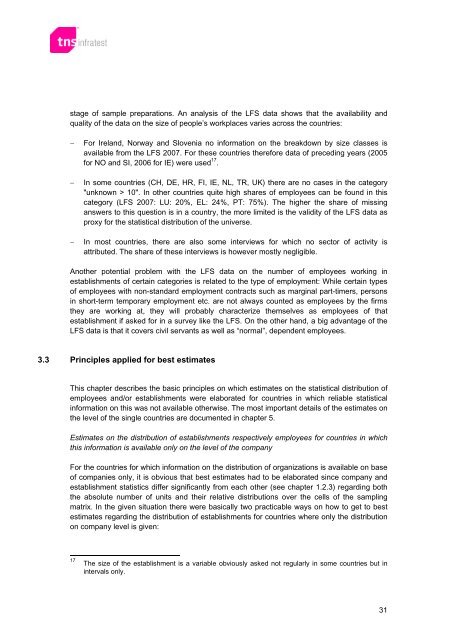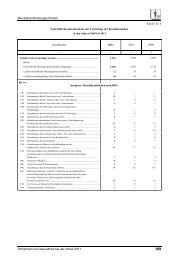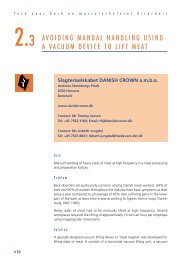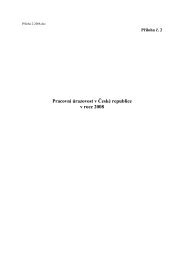ESENER-PSR 2009 - European Agency for Safety and Health at Work
ESENER-PSR 2009 - European Agency for Safety and Health at Work
ESENER-PSR 2009 - European Agency for Safety and Health at Work
You also want an ePaper? Increase the reach of your titles
YUMPU automatically turns print PDFs into web optimized ePapers that Google loves.
stage of sample prepar<strong>at</strong>ions. An analysis of the LFS d<strong>at</strong>a shows th<strong>at</strong> the availability <strong>and</strong><br />
quality of the d<strong>at</strong>a on the size of people’s workplaces varies across the countries:<br />
For Irel<strong>and</strong>, Norway <strong>and</strong> Slovenia no in<strong>for</strong>m<strong>at</strong>ion on the breakdown by size classes is<br />
available from the LFS 2007. For these countries there<strong>for</strong>e d<strong>at</strong>a of preceding years (2005<br />
<strong>for</strong> NO <strong>and</strong> SI, 2006 <strong>for</strong> IE) were used 17 .<br />
In some countries (CH, DE, HR, FI, IE, NL, TR, UK) there are no cases in the c<strong>at</strong>egory<br />
"unknown > 10". In other countries quite high shares of employees can be found in this<br />
c<strong>at</strong>egory (LFS 2007: LU: 20%, EL: 24%, PT: 75%). The higher the share of missing<br />
answers to this question is in a country, the more limited is the validity of the LFS d<strong>at</strong>a as<br />
proxy <strong>for</strong> the st<strong>at</strong>istical distribution of the universe.<br />
In most countries, there are also some interviews <strong>for</strong> which no sector of activity is<br />
<strong>at</strong>tributed. The share of these interviews is however mostly negligible.<br />
Another potential problem with the LFS d<strong>at</strong>a on the number of employees working in<br />
establishments of certain c<strong>at</strong>egories is rel<strong>at</strong>ed to the type of employment: While certain types<br />
of employees with non-st<strong>and</strong>ard employment contracts such as marginal part-timers, persons<br />
in short-term temporary employment etc. are not always counted as employees by the firms<br />
they are working <strong>at</strong>, they will probably characterize themselves as employees of th<strong>at</strong><br />
establishment if asked <strong>for</strong> in a survey like the LFS. On the other h<strong>and</strong>, a big advantage of the<br />
LFS d<strong>at</strong>a is th<strong>at</strong> it covers civil servants as well as “normal”, dependent employees.<br />
3.3 Principles applied <strong>for</strong> best estim<strong>at</strong>es<br />
This chapter describes the basic principles on which estim<strong>at</strong>es on the st<strong>at</strong>istical distribution of<br />
employees <strong>and</strong>/or establishments were elabor<strong>at</strong>ed <strong>for</strong> countries in which reliable st<strong>at</strong>istical<br />
in<strong>for</strong>m<strong>at</strong>ion on this was not available otherwise. The most important details of the estim<strong>at</strong>es on<br />
the level of the single countries are documented in chapter 5.<br />
Estim<strong>at</strong>es on the distribution of establishments respectively employees <strong>for</strong> countries in which<br />
this in<strong>for</strong>m<strong>at</strong>ion is available only on the level of the company<br />
For the countries <strong>for</strong> which in<strong>for</strong>m<strong>at</strong>ion on the distribution of organiz<strong>at</strong>ions is available on base<br />
of companies only, it is obvious th<strong>at</strong> best estim<strong>at</strong>es had to be elabor<strong>at</strong>ed since company <strong>and</strong><br />
establishment st<strong>at</strong>istics differ significantly from each other (see chapter 1.2.3) regarding both<br />
the absolute number of units <strong>and</strong> their rel<strong>at</strong>ive distributions over the cells of the sampling<br />
m<strong>at</strong>rix. In the given situ<strong>at</strong>ion there were basically two practicable ways on how to get to best<br />
estim<strong>at</strong>es regarding the distribution of establishments <strong>for</strong> countries where only the distribution<br />
on company level is given:<br />
17<br />
The size of the establishment is a variable obviously asked not regularly in some countries but in<br />
intervals only.<br />
31
















